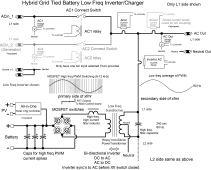Jack Rabbit Off Grid
Solar Enthusiast
- Joined
- Sep 6, 2021
- Messages
- 478
So the other day I decided to wire up my Magnum A/C input. Got that all done and set all the charger settings and gave it a try with my generator all seam to work fine.
I’m only running off a 120v generators and wanted to turn off the charger so more power would bypass to the house. so I used the charger on/off button to turn the charger off but it said standby. I called Magnum tech and asked them. He said that button did nothing and to go into the settings and raise the charger on voltage above what the batteries were and it just wouldn’t charge. So I set on voltage to 56.4 on and left off voltage at 56.4. Did what I wanted to do in the house with full generator power then put all the setting back. (later in settings I found an actual charger off setting) Thanks Magnum tech.
Now the charger will not turn on at all! I start the generator and close the a/c input breaker and nothing. Charger light never comes on or even flickers. So I call tech support back today and explained what was going on. Checked voltage in the load center all the way up to the inverter a/c in and have 125v @ 60 hz. The tech told me the inverter was bad and to send it in for service.
so I decide to remove the cover from the inverter section to look around inside. Everything looks fine. Nothing burned or no bad smells. I did see a relay on one of the boards called the parallel board that is directly powered by the a/c in. That’s the only thing I can think of that it’s just bad?
I have also tried soft and hard reseting the damn thing and nothing.
Am I missing something simple?
The Magnum tech said it’s under warranty since it only a few weeks old but that not the point. The point is I’ll be back to running generators 24/7 until I get it back. Also the place I need to take it or ship it is close to 200 miles from me.
This is the exact reason why I don’t like buying all in one units. One thing breaks and your out all!
At least I still have my trusty 600w EG4 charger.
I’m only running off a 120v generators and wanted to turn off the charger so more power would bypass to the house. so I used the charger on/off button to turn the charger off but it said standby. I called Magnum tech and asked them. He said that button did nothing and to go into the settings and raise the charger on voltage above what the batteries were and it just wouldn’t charge. So I set on voltage to 56.4 on and left off voltage at 56.4. Did what I wanted to do in the house with full generator power then put all the setting back. (later in settings I found an actual charger off setting) Thanks Magnum tech.
Now the charger will not turn on at all! I start the generator and close the a/c input breaker and nothing. Charger light never comes on or even flickers. So I call tech support back today and explained what was going on. Checked voltage in the load center all the way up to the inverter a/c in and have 125v @ 60 hz. The tech told me the inverter was bad and to send it in for service.
so I decide to remove the cover from the inverter section to look around inside. Everything looks fine. Nothing burned or no bad smells. I did see a relay on one of the boards called the parallel board that is directly powered by the a/c in. That’s the only thing I can think of that it’s just bad?
I have also tried soft and hard reseting the damn thing and nothing.
Am I missing something simple?
The Magnum tech said it’s under warranty since it only a few weeks old but that not the point. The point is I’ll be back to running generators 24/7 until I get it back. Also the place I need to take it or ship it is close to 200 miles from me.
This is the exact reason why I don’t like buying all in one units. One thing breaks and your out all!
At least I still have my trusty 600w EG4 charger.





